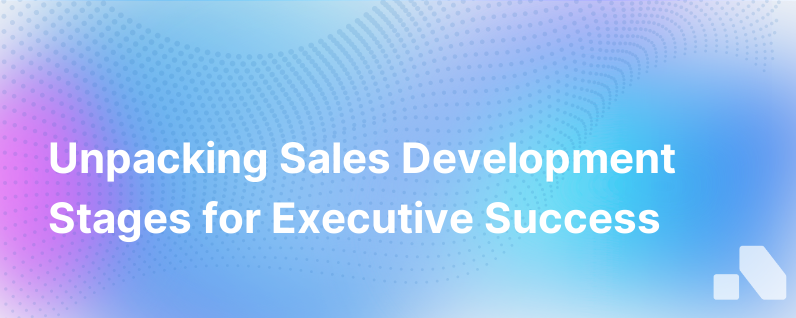
In the quest for sales success, understanding the sales development stages is akin to a navigator comprehending the map's legend—it's crucial for interpreting the journey correctly and reaching the desired destination.
Sales development, often seen as the lifeblood of a B2B sales operation, consists of multiple stages that, when managed effectively, can significantly increase a company's sales pipeline and overall health. It forms a bridge between marketing-induced leads and the closing power of a sales team, nurturing and qualifying potential prospects into actionable opportunities.
Let's take an immersive journey through each stage of this process, exploring the intricate details that can make or break a sales development strategy.
Prospect Research and Targeting
The first stage involves identifying and targeting the right prospects. Sales development reps (SDRs) must tap into a deep well of market knowledge and client insights, searching through a vast ocean of potential to fish out quality leads that align with the product's value proposition.
- Market Segmentation: Begin by partitioning the market into segments where optimal product-market fit exists. This precision ensures that the sales pitch resonates with the recipient's needs and industry pain points.
- Ideal Customer Profile (ICP): Construct a detailed profile of the ideal customer—the North Star guiding the identification of promising leads.
- Data-Driven Tools: Leverage technology platforms to glean through demographics, firmographics, technographics, and buying signals. Tools such as Aomni quickly consolidate valuable data, aiding the SDR in crafting a targeted outreach list.
Outreach and Initial Contact
Now, with the intel gathered, it's time for the SDRs to initiate contact through a mix of channels like email, social media, phone calls, or event networking. This stage is fraught with rejections and non-responses; however, persistence and skill can lead to promising connections.
- Personalization: Tailor messages to the prospect's industry, role, and specific challenges. Use A/B testing to determine which message resonates best and adapt strategies accordingly.
- Cadence Management: Develop a systematic pattern of touches, applying a balanced cadence that entices without overwhelming. Tools like HubSpot or Salesforce enable SDRs to automate and track this process efficiently.
Qualification and Needs Analysis
Once initial contact has been made, the next formidable stage is to qualify the prospect through the BANT framework (Budget, Authority, Need, and Timeline) or other methodology suitable to the business model.
- Discovery Calls: Schedule discovery calls or meetings to delve into the prospect's needs, understand their purchasing process, and identify key decision-makers.
- Sales Qualification Frameworks: Tools like MEDDIC or CHAMP can guide the conversation to extract actionable intelligence that informs the viability of a prospect.
Presentation and Education
With a qualified lead, the sales narrative enters a stage where the goal is to nurture and educate the prospect about the product or service, shaping their perception and laying the groundwork for the value proposition.
- Content Distribution: Share whitepapers, case studies, webinars, and other educational materials that highlight unique selling points and showcase customer success stories.
- Product Demonstrations: Offer personalized demos that exhibit how the product or service solves their specific pain points, moving from theoretical benefits to practical application.
Objection Handling
Obstacle navigation is a critical stage in sales development. Prospects will bring up concerns and hesitations that an adept SDR must address with finesse, affirming their value proposition.
- Empathy and Active Listening: Be attuned to the prospect's reservations, seeking to understand before being understood.
- Preparation and Knowledge: Maintain a repository of common objections and effective counterarguments, including competitive intelligence and detailed product knowledge.
- Collaboration: Work closely with sales and marketing teams to ensure consistent messaging and strategy.
Advancement and Follow-Up
In the penultimate stage, SDRs must encourage the lead forward in the sales cycle, often requiring multiple follow-ups and nudges towards decision-making.
- Persistent Follow-Up: Employ CRM systems to automate reminders for timely follow-ups while keeping the conversation warm and engaged.
- Value Reinforcement: Every touchpoint should reinforce the value, using new information or testimonials that might sway the decision in your favor.
Handover to Sales Team
The final stage culminates in passing the baton to the account executive or sales team for closure. This transition should be seamless, with a comprehensive handover that includes detailed notes and insights gathered throughout the engagement.
- Internal Debriefing: Organize a meeting with the sales team to share context, discuss strategy, and establish expectations for the next steps.
- Documentation: Ensure all interactions, findings, and materials are meticulously documented in the CRM to provide a full history of the relationship.
Implementation and Iterative Learning
Sales development is an ongoing process of refinement and learning. Collect data, analyze the performance of different stages, and iterate your approach regularly.
- Data Analytics: Use engagement metrics to identify bottlenecks or stages that need more attention.
- Training and Development: Regularly update your SDR team's training material based on real-world engagement and feedback
Conclusion
Navigating the sales development stages is an art and a science, requiring skill, technology, and perseverance. By understanding and optimizing each stage, B2B startups can cultivate a robust pipeline that fuels growth and opportunity.
For teams equipped with AI platforms like Aomni, handling these stages becomes more streamlined and informed, allowing sales development reps to work smarter, not harder, and deliver strategic sales success.